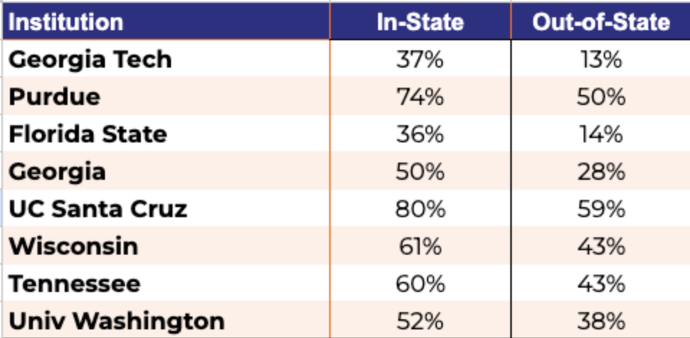This page is licensed under Creative Commons under Attribution 4.0 International. Anyone can share content from this page, with attribution and link to College MatchPoint requested.
Navigating In-State vs. Out-of-State Colleges: A Guide for Students and Parents
Did you know that choosing between in-state and out-of-state schools can significantly impact both your acceptance chances and your wallet? While flagship state universities often heavily favor in-state applicants (with acceptance rate differences as high as 30%), the cost difference can be staggering - we're talking up to $33,000 more per year for out-of-state students! But don't cross out-of-state schools off your list just yet. Many public universities offer generous scholarships to attract top out-of-state talent, like the University of Oklahoma's Award of Excellence which provides $80,000 over four years. When building your college list, consider factors beyond just cost and acceptance rates - think academic programs, campus culture, and career opportunities.

As you embark on your college search, understanding the differences between applying as an in-state or out-of-state student is crucial. This guide will break down the key factors affecting your college choices and admissions chances, helping you make informed decisions about your future.
Acceptance Rates: A Tale of Two Types of Schools
When it comes to getting into public universities, your home state can make a big difference. However, this difference varies depending on the type of school.
Flagship Universities
These are often the most well-known public schools in a state, typically showing a significant gap in acceptance rates. Here are a few examples:

At other public universities, including many land-grant schools, the difference isn't as dramatic:
- Iowa State University admitted 92% of in-state applicants and 87% of out-of-state applicants last year.
- The University of Kansas admitted 93% of in-state applicants and 76% of out-of-state applicants.
These numbers show why it's crucial to consider your residency when evaluating your chances at different public universities.
The Cost Factor: A Big Difference for Your Wallet
Perhaps the most significant difference between in-state and out-of-state admissions is the price tag. Public universities usually charge much less for students from their state because these schools receive funding from state taxes.
Let's look at some examples:
1. University of California, Berkeley:
- In-state students pay about $14,300 a year
- Out-of-state students pay about $44,100 a year
- That's a difference of nearly $30,000 every year!
2. University of Virginia:
- In-state students pay about $17,800 a year
- Out-of-state students pay about $50,900 a year
- The difference here is over $33,000 per year
3. Ohio State University:
- In-state students pay about $11,500 a year
- Out-of-state students pay about $33,500 a year
- That's a difference of about $22,000 each year
These substantial price differences can make attending an out-of-state public university challenging for many families. However, don't let these numbers discourage you just yet.
Out-of-State Scholarship Opportunities
Many public universities offer attractive scholarship packages to entice high-achieving out-of-state students. Let's look at two examples:
University of Oklahoma offers several scholarships for out-of-state students based on academic merit:
- Award of Excellence: Provides $20,000 per year for four years (total $80,000) for students with a 3.75+ GPA and 32+ ACT or 1430+ SAT.
- Distinguished Scholar Award: Offers $17,000 per year for four years (total $68,000) for students with a 3.75+ GPA and 30-31 ACT or 1360-1420 SAT.
University of Arkansas has a unique approach with its New Arkansan Non-Resident Tuition Award:
- This scholarship pays 80% to 90% of the difference between in-state and out-of-state tuition rates.
- Eligibility is based on GPA and test scores. For example, students with a 3.20+ GPA and 24+ ACT (or equivalent SAT) can receive 80% of the difference.
Additionally, some states have agreements that let students from nearby states pay reduced tuition. For example, the Western Undergraduate Exchange (WUE) program helps students from western states pay less at certain schools in other western states.
Building Your College List: Balancing Your Options
When creating your list of colleges to apply to, it's important to consider both the differences in acceptance rates and costs. Here are some tips to help you create a balanced list:
1. Start close to home: Look at public universities in your state first. These will likely be the most affordable and might be easier to get into.
2. Find your "safe" schools: Include at least one in-state public university where you're confident you'll get in and your family can afford.
3. Look for scholarships at out-of-state schools: Research universities that offer great scholarships to attract top out-of-state students.
4. Check for tuition agreements: See if your state has any deals with other states to offer lower tuition.
5. Mix it up: Ensure your list includes schools where you have different chances of getting in, keeping in mind the differences for in-state and out-of-state students.
6. Think about all the costs: Consider not just tuition, but also housing, food, travel, and other expenses when comparing schools.
7. Don't forget private schools: While we've focused on public universities here, remember that private schools often charge the same tuition for all students, regardless of residency. They might also offer substantial financial aid.
While financial considerations and admission chances are crucial, don't forget to factor in other important aspects:
- Academic Programs: Research the strengths of each university's programs in your areas of interest.
- Campus Culture: Consider the type of college experience you want, including factors like location, size, and available extracurricular activities.
- Career Opportunities: Look into internship programs, job placement rates, and alumni networks.


